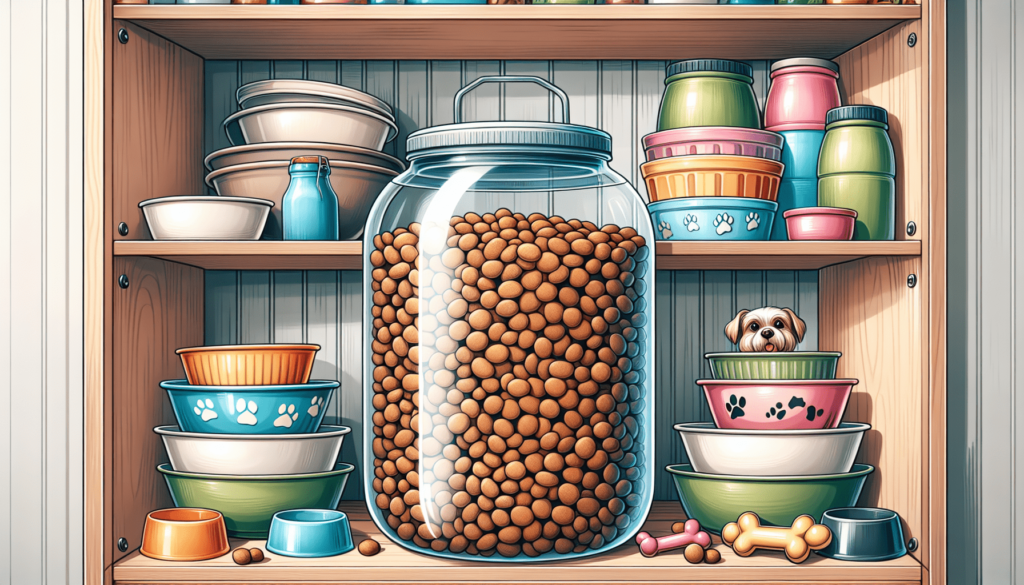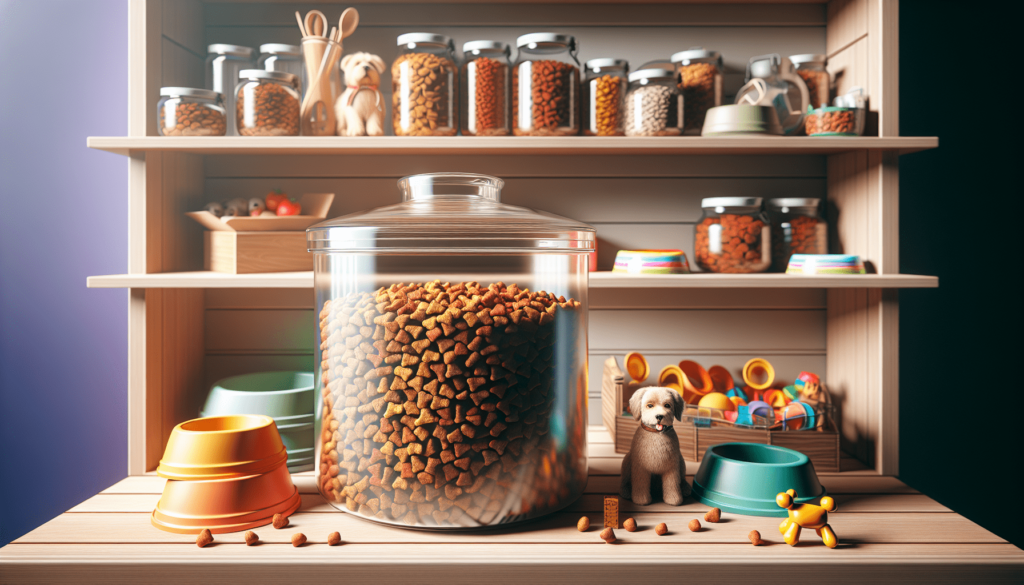Have you ever wondered how to store your dog food properly? As a responsible pet owner, ensuring that your furry friend’s food is kept fresh and safe is as important as selecting the right diet for them. Improper storage can lead to loss of nutrients and even allow for harmful bacteria or pests to spoil the food, which could affect your dog’s health. So, let’s explore this topic in depth to ensure your canine companion enjoys every meal with all the benefits it’s meant to provide.

Why Proper Storage Matters
The way you store your dog’s food directly impacts its freshness, nutritional value, and safety. Poor storage conditions can degrade the quality of the food and even pose health risks. By understanding why storage matters, we can set the stage for better practices.
Nutrient Preservation
Maintaining the nutritional integrity of dog food is crucial. Many dog foods are fortified with essential vitamins and minerals that can deteriorate if not stored correctly. Preserving these nutrients means your dog receives the full benefits of its diet, promoting overall health and energy.
Preventing Contamination
Proper storage is your first defense against contamination. Whether it’s dry kibble, canned food, or homemade meals, keeping your dog’s food safe from pests, bacteria, and mold is vital. Contaminated food can lead to illnesses ranging from mild upset stomachs to more severe health problems.
Ensuring Freshness
The fresh taste of food is as important to dogs as it is to humans. Stale or spoiled food can lead to mealtime struggles or even refusal to eat. By storing food correctly, you’re ensuring every meal is appetizing and enjoyable.
Best Practices for Storing Different Types of Dog Food
Different types of dog food require different storage solutions. Each has unique storage needs, whether it’s dry kibble, wet cans, or raw food diets. Let’s take a closer look at how to properly manage these different varieties.
Storing Dry Kibble
Dry kibble is a popular choice due to its convenience and shelf life. However, exposure to air, light, and moisture can quickly degrade its quality.
Keep it sealed: Always store kibble in an airtight container to prevent exposure to air and moisture. Look for containers made from food-grade materials.
Cool and dark location: Place the container in a cool, dark place, such as a pantry, to protect it from temperature fluctuations and light. Avoid storing kibble in garages or outdoor spaces where temperature shifts are common.
Original packaging: Some dog food bags are designed with special linings to preserve freshness. Consider keeping the kibble in its original bag and placing the bag inside the airtight container for added protection.
Storing Wet Canned Dog Food
Canned dog food offers different challenges and advantages for storage, primarily related to its moisture content.
Before opening: Store unopened cans in a cool, dry place. Most wet dog foods have long shelf lives when stored correctly, but always check expiration dates.
After opening: Once opened, transfer unused portions to airtight containers. Store these in the refrigerator and aim to use them within a few days to maintain freshness and prevent spoilage.
Storing Homemade or Raw Dog Food
For those who dedicate time to making homemade or raw meals, the focus should be on safe handling and freezing.
Preparation and portioning: Prepare and portion meals in batches to reduce handling and the chance of contamination.
Freezing: Store portions in freezer-safe containers or bags. Frozen meals should be thawed in the refrigerator overnight to maintain safety.
Use timelines: Always use homemade or raw meals within the timeframes recommended by veterinarians or nutrition experts to avoid bacterial growth.

Tips for Maintaining Long-lasting Freshness
Beyond the specific requirements of different food types, several general practices can enhance storage and extend the freshness of your dog’s food.
Frequent Inventory Checks
Regularly checking your inventory helps you keep track of expiration dates and consumption levels. This practice prevents food from going bad before it’s consumed and ensures you’re always stocked up.
Avoid Bulk Buying
While buying in bulk might seem economical, it’s not always best for maintaining food freshness. Unless you have a large household with multiple dogs, consider purchasing quantities that suit your typical consumption rate to ensure it’s used while fresh.
Use Measuring Tools
Using measuring tools ensures you’re dispensing the right amount of food at each meal, reducing waste. Over-pouring can lead to contamination from spillage and an increased risk of spoilage.
Addressing Special Storage Needs for Puppies and Seniors
Puppies and senior dogs often have specialized dietary needs that can affect how their food should be stored. Let’s address these needs to ensure every life stage is managed properly.
Puppies
Puppy food is formulated with extra nutrients to support growth and development. Proper storage is essential to maintaining these enhanced nutritional levels. Be particularly vigilant about expiration dates, as puppies are sensitive to nutrient deficiencies and contaminants.
Senior Dogs
Senior dogs require diets that support aging bodies, often with added joint support or reduced calories. Freshness is crucial for palatability, especially if taste changes affect an older dog’s interest in food. Special attention should be paid to moisture control to prevent arthritis or other problems.
Recognizing Signs of Spoiled Dog Food
Understanding the indicators of spoiled food can prevent health issues in dogs. Regular inspections are necessary for any stored food to ensure it’s safe to eat.
- Foul odor: Any rancid or off-putting smell is a clear indicator of spoilage.
- Mold or pests: Visible mold or insects indicate contamination. Immediately discard affected bags and clean storage areas thoroughly.
- Changes in texture: Any sudden change in the texture of dry kibble or canned food could suggest deterioration.
Using the Right Containers for Storage
Choosing appropriate storage containers can significantly affect your dog food’s preservation. Certain materials and designs can offer better protection against environmental factors.
Airtight Containers
Containers with airtight seals help to minimize exposure to air and moisture. Options made from stainless steel, glass, or BPA-free plastic can maintain food quality.
Stackable Containers
For efficient storage, consider stackable containers, which help to organize food supplies without compromising on security and freshness.
Labeling
Label containers with purchase dates and expiry details. This organizational step helps manage rotation and ensures you use food while it’s still fresh.
FAQ: How Do I Store Dog Food Properly?
How do I ensure my dog food stays fresh longer?
Keep it airtight and stored in a cool, dry place. Always follow specific storage guidelines for the type of food, whether it’s kibble, canned, or homemade.
Can I use regular kitchen containers to store dog food?
It’s best to use containers designed for pet food that are airtight and made of food-grade materials. Regular kitchen containers may not provide adequate sealing.
How often should I check for spoiled food?
Regular inspections, preferably every time you feed your dog, help catch any signs of spoilage early. This practice ensures the food remains fresh and safe.
Is it good to refrigerate dry dog kibble?
Dry kibble does not need refrigeration, just a cool and dry storage space. Refrigeration can cause condensation, which may spoil kibble sooner.
What if my dog refuses to eat stored food?
If your dog refuses to eat stored food, check for signs of spoilage. Ensure you are following proper storage procedures and consider rotating fresh food into their diet. If problems persist, consult your veterinarian.
Storing dog food properly is not just about keeping it fresh; it’s an ongoing commitment to your dog’s health and happiness. By understanding and implementing the right storage practices, you can provide your pet with the best nutrition and care possible, ensuring they thrive alongside you every day.



